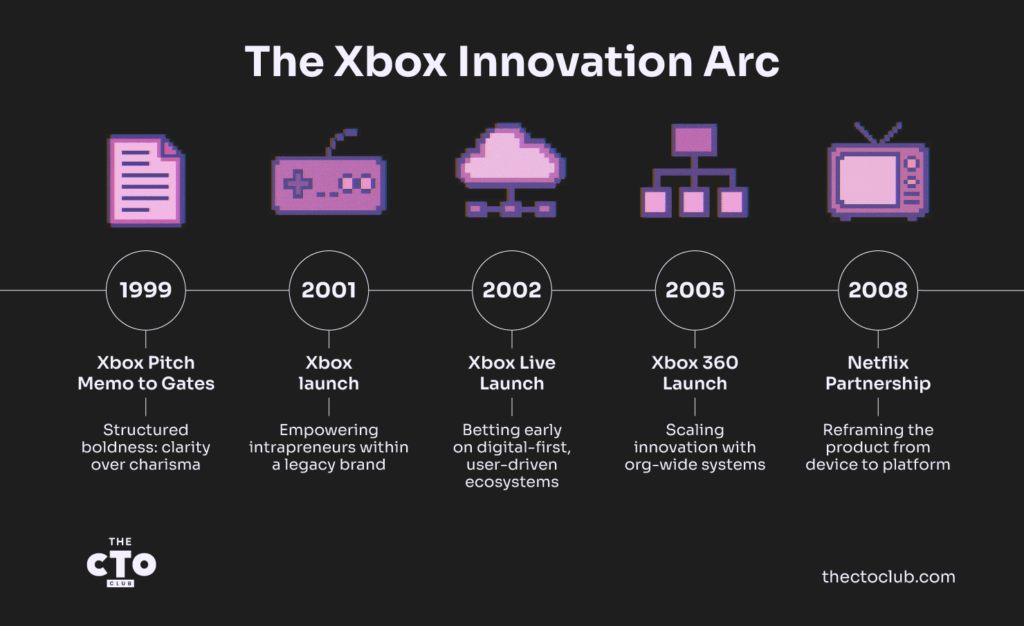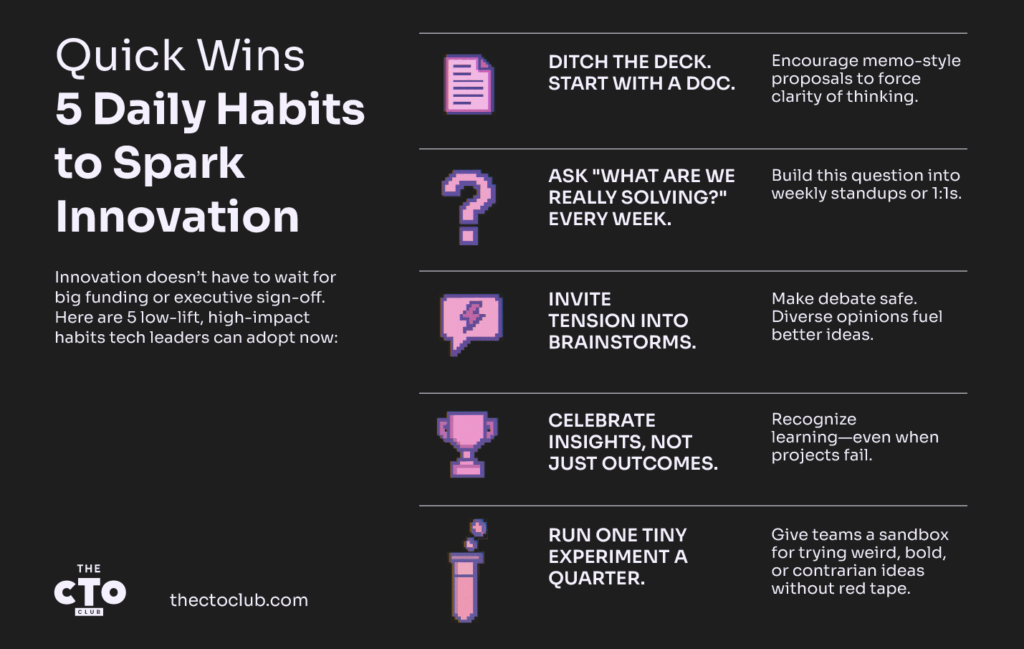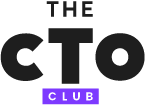What happens when engineers aren’t just told to “innovate,” but are simply given the freedom to build what they love, even if it doesn’t have immediate business value?
“I treat every small inefficiency or friction point as a potential innovation seed. Whether it’s latency in replication workflows or gaps in our internal tooling, I block time each week to explore solutions beyond the ‘just fix it’ mindset. This keeps innovation part of the flow, not an afterthought," shares Hardik Ruparel, Software Engineer, Nutanix.
Before it was a $16 billion empire, Xbox was an idea so audacious it almost got laughed out of the room. When the team first pitched the concept to Bill Gates, his response was scathing. He reportedly called it an "insult" to everything Microsoft had built.
The original Xbox team wasn’t a formal product group or a polished task force. It was a collection of engineers and gamers—people who stayed late, played together, and obsessed over what gaming could become. They didn’t wait for permission. They didn’t chase KPIs. They just loved it. And so they built it.
This case study examines regular tech workers who bet on their instincts and asks important questions: What happens when you let your engineers chase what drives them? How does passion-fueled chaos become iconic innovation? What can other engineers and aspiring tech leaders learn from these lessons?
"The biggest challenge is inertia—' it already works' becomes a silent blocker. In large-scale systems, change can feel risky. But what makes it worth it is seeing how a small tweak, like optimizing checkpoint syncs, can lead to a 30% reduction in failover recovery time. That’s the kind of behind-the-scenes win that matters," emphasizes Hardik.
Have a story like this of your own? We're collecting "Xbox moments"—times when you or your team built something no one asked for, but couldn’t stop thinking about. Share yours here.
Problem: A Company at Risk of Irrelevance
In the late 1990s, Microsoft had a problem. Sony was dominating the living room. Microsoft, long the ruler of desktop productivity, had no real presence in consumer entertainment, and leadership knew it. But there was no official task force working on a solution.
Inside the company, a handful of engineers—gamers themselves—recognized what others hadn’t: Microsoft wasn’t just missing a market opportunity, it was missing a cultural moment. The emotional disconnect between Microsoft’s product lines and the emerging entertainment space was stark. And while leadership saw a strategic risk, these engineers felt something more visceral: a gap that needed to be filled.
They didn’t wait for a directive. They saw the user pain—Microsoft had nothing to offer the modern gamer—and they acted.
Emotional storytelling is underrated. I’ve seen technically strong ideas get traction only when we tied them to real user pain points. That human angle builds momentum.
Building Xbox wasn’t a sanctioned initiative. These engineers risked their reputations and careers to challenge leadership’s thinking. There was no clear structure or guaranteed support. Just an instinct that this mattered—and that someone needed to move.
Solution: Passion Over Process

The original Xbox team was a crew of passionate engineers, developers, and gamers who worked outside formal scopes because they couldn’t not build this thing. They fused two worlds—software development and immersive entertainment—and dreamed up what gaming could become.
They were intrapreneurs in the truest sense. Not hired to innovate, but driven to. And that work sparked a new mindset.
As Anant Agarwal, CTO at Aidora, says, “Innovation isn’t about what’s shiny or cool—it’s about solving a real user problem with care.”
Result: A Culture Shift
This case study is a reminder that innovation doesn’t always come from formal processes. It is in the everyday work, sometimes the mundane tasks, and often starts with a few passionate people.
Aditya Sastry, CTO of Caddi, explains: “My job isn't to push engineers to innovate. It's to hire people who push me, then remove the obstacles to innovation.”
Xbox became a $16B business and a globally recognized platform, but its biggest impact was cultural.

The Ripple Effect
- It gave permission to other teams to pursue bold, messy, personal ideas.
- It proved that internal passion projects can have massive business outcomes.
- It inspired others inside and outside the company to think, “What if we just started building?”
- It showed that your best ideas might already be brewing—quietly—on the edges of your org.
“Innovation isn’t about big swings alone,” Zalak Trivedi, Head of Embedded Analytics at Sigma, adds, “It’s the subtle enhancements that streamline workflows or improve user interactions. It has to be baked into the culture and structure, not isolated in special projects.”

Practical Takeaways
- Don’t wait for business value to be obvious—value often emerges after the energy.
- Protect the “mosh pit” energy. Don’t over-process it.
- Find your innovators: Where are your people staying late because they love the problem?
- Instead of asking “Is this viable?”, ask: “Who deeply cares about this?”
- Create space for experimental projects and unsanctioned ideas.
- Champion passion early, not just performance.
- Reward insight, not just metrics.
- Let belief drive exploration—even before there’s a deck.
Irina Bukatik, VP of Product at Branch, posits, “Innovation is constantly threatened by quarterly pressures… but the most significant innovations emerge when we're solving real problems rather than chasing innovation for its own sake.”
Let Them Build What They Love
The Xbox team didn’t wait for permission. Yes, they were engineers, but they were also storytellers, worldbuilders, and gamers. By blending disciplines and building momentum before they had permission, they rewrote what innovation could look like inside a tech giant.
And eventually, they pitched something that would change Microsoft (and the gaming world) forever.
"That spark—the moment when an offhand Slack idea becomes a company-wide breakthrough—is why we push. The real ROI is how contagious that momentum becomes,” says Aditya.
The lesson? Don’t wait for the business case to be perfect. Look for the people who can’t stop thinking about a problem, and let them build.
Because your next billion-dollar idea might already exist. It’s just waiting for you to get out of the way.
If this story reminded you of a moment when you—or someone on your team—followed their gut and built something bold, we want to hear about it. Share your Xbox moment here.




